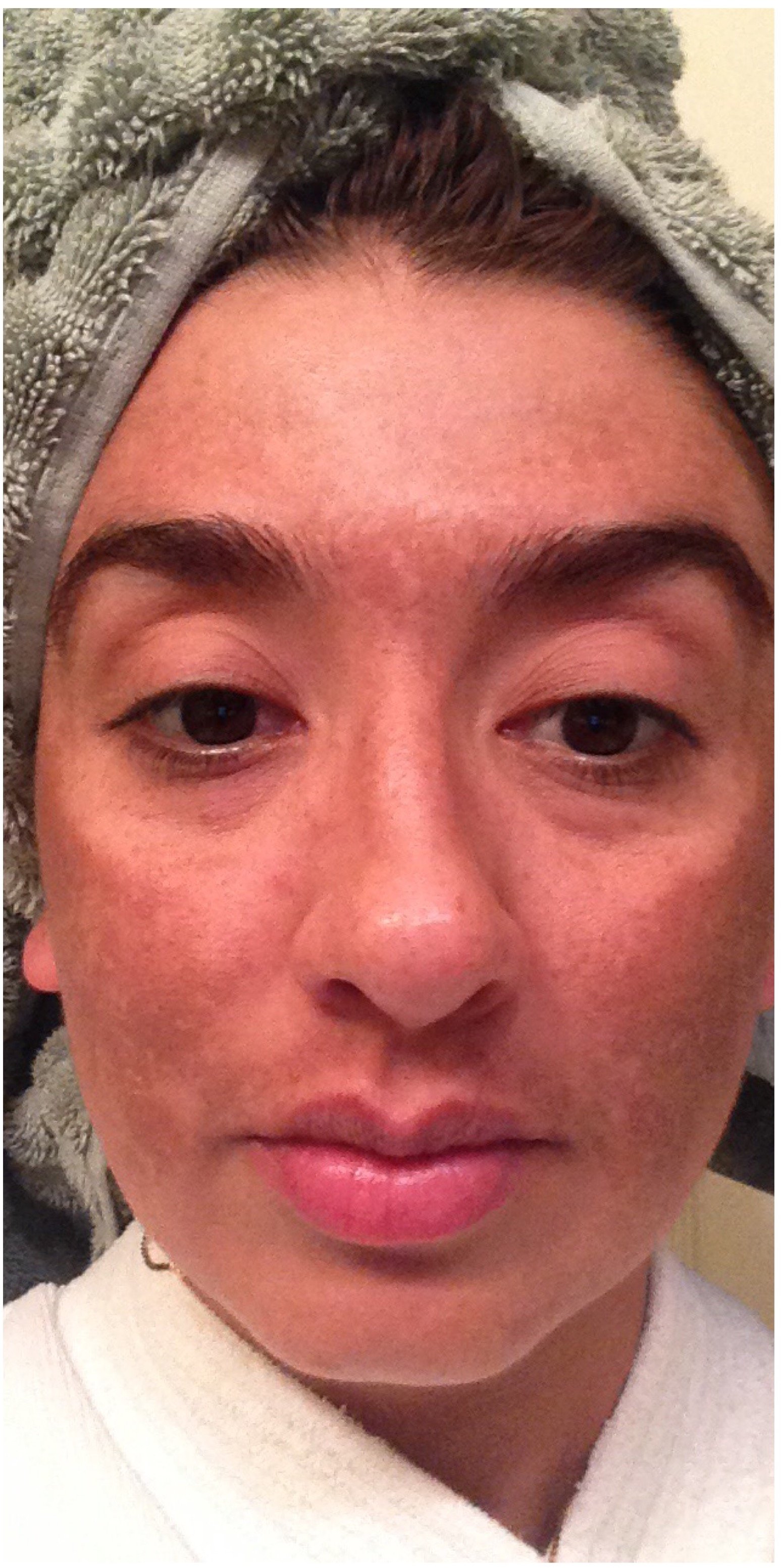By Katrina Yokoyama
Expert Tips for Treating Hyperpigmentation
Discovering My Melasma and Treating Hyperpigmentation
I began treating hyperpigmentation that I discovered on my skin, at the vibrant and youthful age of 26. Just one year into my esthetic career, not a wrinkle or clogged pore in sight, I finally had good skin! My 10 year battle with cystic acne was over and my skincare worries seemed to be a thing of the past. My main skin care goal, at 26 was to start to incorporate anti-aging products into my “acne free” home care. I was considering adding an eye cream. I had regular compliments on how great my skin looked, along with questions on what was I doing to maintain clear skin.
Then during a trip to Hawaii there it was… the first signs of my now 13 year battle with Hyperpigmentation.

2 Types Of Hyperpigmentation
Environmental Hyperpigmentation
Hyperpigmentation can be caused by sun damage, inflammation, or other skin injuries along with excess production of melanin. Melanin is produced by melanocytes at the lower layer of the epidermis and is responsible for producing color in the body in places such as the eyes, skin, and hair. As the body ages, melanocyte distribution becomes less diffuse and its regulation less controlled by the body. UV light stimulates melanocyte activity, and where the concentration of the cells is greater, hyperpigmentation occurs.
Post Inflammatory Hyperpigmentation
Another form of hyperpigmentation is post inflammatory hyperpigmentation. These are dark and discolored spots that appear on the skin following acne (trauma) that has healed.
Then There’s Melasma
Melasma, also known as the mask of pregnancy (when present in pregnant women), is a tan or dark skin discoloration. Melasma is thought to be caused by sun exposure, genetic predisposition, hormone changes, and skin irritation. Although it can affect anyone, it is particularly common in women, especially when pregnant.
What Causes Hyperpigmentation?
How did I get it? I mean I’m only 26 (at the time) and wore sunscreen religiously. I forced myself to remember the times that I was irresponsible with UV exposure, there were few times I used a tanning bed, the time I fell asleep by the pool in my teens, but I wore my SPF 45.
What The Doctor Told Me Causes Hyperpigmentation
My doctor told me that I had melasma, and asked if I might be pregnant. I explained that I wasn’t and had been on birth control for 7 years. My doctor then suggested it may have been a laser peel that I had or the years of UV exposure as a lifeguard and swim teacher. I explained that I used SPF , reapplied it every 2 hours and wore a hat/visor. I was baffled because I followed the instructions.
How did I get this when I used sun protection? Yes, I had been using sunscreen. Could the sunscreen be a culprit?
SPF and Inflammation
Obviously, I was inflamed, how and why, well that’s another topic, but the fact that I had discoloring in the shape of snorkel mask on my face at 26 years old, was a clear indication I was in fact inflamed. I applied SPF and was not burned, but had huge dark tan on my face that looked as if I had prolonged sun exposure, yet, I was only in the sun for a few hours. I began to dig in and do my own research on hyperpigmentation.
What I Learned
I began reading different books and attending continuing education classes. I learned the hyperpigmentation that I was seeing on my face was brought about by the sun on that trip. The sun exposure on that fateful trip to Hawaii helped to pull out years of damage, inflammation, hormones and sunburn/tan exposure I had.
It takes years for that damage to surface. I was 26 years old and have Fitzpatrick 3/4 skin tone which rarely burns. My skin is actually more susceptible to an abundance of melanin production, which is what populates as hyperpigmentation on the skin. Although, I began to believe my attempts to protect my skin all these years may have lead to more hormone distribution and inflammation with the type of SPF that I used.
Hormones And Hyperpigmentation
Topical SPF comes in two forms – Physical and Chemical. 15+ years ago, most over the counter sunscreens options were are all chemical based. That mass marketed SPFs that I was using were all chemical based. There is some research that shows some of the chemical SPFs have been linked to disrupt hormones in the reproductive system causing an abundance of estrogen production.
When a woman is pregnant she produces more estrogen that may activate the melanocytes and produce dark patches on the cheeks, lips and for head, this is known as a “pregnancy mask”. After pregnancy and breast feeding the estrogen production levels out and this, in most cases disappears over time.
However, in my case, I was not or had not been pregnant but was on birth control which was estrogen based.
Could a mixture of birth control and chemical exposure with SPF be the culprit in my case?
Chemical SPF
Chemical sunscreens absorb the rays, so one must reapply often. How often depends on how soon it takes for one burn. Let’s say one uses SPF 15 and starts to burn within two minutes after exposure. I learned to determine how often to reapply depends on these factors: take the rating of the SPF and times it by the amount of minutes it takes one to burn and there is your reapply figure. In this case, SPF 15 times two minutes would mean you need to reapply every 30 min. The rays are being absorbed by the chemical SPF to protect from burns, and now that SPF is declining in efficiency, reapplication is necessary.
However, an SPF that is 15 protects against 93% of the rays, a 30 SPF protects against 97% and 50 SPF protects against 98%.
So possibly my reapplication every two hours was not nearly enough, combined with the heat reacting inflammation, along with chemical exposure and hormones in my body that could have contributed to the hyperpigmentation. Many factors and years of protection with chemical SPF could had disrupted reproductive hormone production that results in activating the melasma/hyperpigmentation.
Physical SPF
Physical sunblocks using minerals like Zinc and Titanium bounce the rays from the skin, protecting it from the rays. The rays aren’t being absorbed but reflected, well this just sounds genius. If you’re not sweating from physical activity, water sports or rubbing the product off! But zinc, that thick white sunscreen that surfers wear? I don’t want to use that! And mineral makeup, full of titanium with color pigments, well that was now having a color reaction giving a grey/ashy tone to every sun spot. I see why consumers would want to go the chemical route instead.
4 Tips For Treating Hyperpigmentation
1. Physical SPFs That Contain Antioxidants
The key to treating hyperpigmentation and preventing future hyperpigmentation isn’t just the SPF. I love physical SPFs with Titanium Dioxide and Zinc Oxide that are filled with antioxidants that will repair the skin due to our exposure to toxins, hormone disturbances and inflammation.
Vitamin E is a great antioxidant for treating hyperpigmentation: it is a fat-soluble essential nutrient containing anti-inflammatory properties. It helps support the immune system, cell function, and skin health. This antioxidant is effective at combating the effects of free radicals produced by the metabolism of toxins in the environment and so beneficial at reducing UV damage to skin.
Downside: it only has one molecule. This means that when your cells need the antioxidant to stop the oxidation, the Vitamin E comes to help, but the damaged cells takes Vitamin E’s only molecule to reverse the damage. But now, that Vitamin E has turned into a free radical! Here we go again, thinking we are helping but now contributing to the inflammation.
This is why Vitamin C is so important. Vitamin C has two molecules meaning it splits, using Vitamin C with E is a win win because the C comes to the rescue by giving a molecule to E, then it doesn’t become a free radical when it’s providing assistance to damaged cell. The C splits any time it is at service to a cell, and makes another molecule keeping the system intact!
2. Vitamin C Product For Home Care
Vitamin C has many beneficial effects for combating treating hyperpigmentation, photo damage and stabilizing collagen by increasing collagen protein synthesis for repair of damaged skin. It can aide in brightening the skin and overall help with inflammation and aging in the skin.
Now we know how to protect and feed our skin cells, but how in treating hyperpigmentation, how do we rid the discoloration without causing more inflammation by heat, laser or chemical exposure? I have not found a way to rid hyperpigmentation 100% however, I have found ways to inhibit the melanin production in a non-aggressive way.
This is just the beginning!
3. Tyrosinase Inhibitors Products For Home Care
Tyrosinase is an oxidase that is the rate-limiting enzyme for controlling the production of melanin. Over-production of melanocytes due to the body’s response in protecting our skin from inflammation due to trauma, sun or hormone production, creates the dark spots, hyperpigmentation/melasma. Tyrosinase inhibitors stop over production of melanocytes. Inhibiting this overproduction of melanocytes is the key component in treating hyperpigmentation. First, home-care products can help to break up the exterior look of hyperpigmentation. Products containing Tyrostat-11, Symwhite, and marrubium stem cell are a good place to start.
Once the melanocytes have been activated, any trauma will continue to spread the activated melanocyte cell. Using tyrosinase inhibitors topically aide in treating the discoloration, making the appearance even toned and in some cases significantly reduce or rid the hyperpigmentation. Think of it as putting a stray jacket on the melanocyte. They are there, they have been activated, they aren’t leaving, but we can try to control by inhibiting the production.
4. Chemical Peels
First, we must learn how to treat with chemical peels. I’ve used the Jessner’s peel on some clients. I have also found much success with layering different acids. Lactic acids, multi-fruit acids, glycolic and mandelic acids are great. If you work with a professional skin care line, ask them which of their peels will work best to treat hyperpigmentation.
I believe that all factors of my lifestyle contributed to my Hyperpigmentation from, sun exposure, birth control, aggressive laser treatments and chemical toxin exposure. Professional resurfacing treatments along with effective home care of Vitamin C and tyrosinase inhibitors have lightened hyperpigmentation significantly for myself and my clients.
Every year new treatments and products come into this amazing field of esthetics and it excites me to continue to learn what is yet to come.

 Katrina Yokoyama, award winning licensed esthetician
Katrina Yokoyama, award winning licensed esthetician
Katrina Yokoyama is an award winning, licensed esthetician. After eight years of working as an esthetician in day spas, she opened her own treatment facility in 2013, Trin Spa Skin and Wellness – a boutique luxury skin spa…..Read More.
